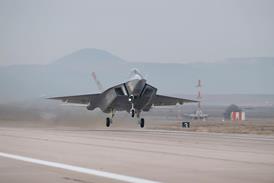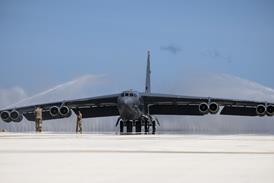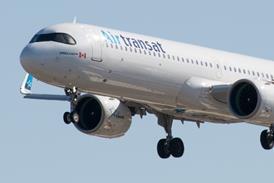GUY NORRIS / LOS ANGELES
Demonstrations are planned for January using a low-cost gun-launching technique
Free-flight demonstrations of a fin-stabilised mini-scramjet (supersonic combustion ramjet) are scheduled to start in January at the Arnold Engineering Development Center (AEDC), Tennessee, using a low-cost, gun-launching technique which has been developed by Allied Aerospace.
The firings - which were sponsored by the US Defense Advanced Research Projects Agency (DARPA) - pave the way for scramjet missile and powered-projectile trials which have been scheduled for the end of next year by the US Navy and the US Army, respectively.
The tests follow the success of an initial series of trials at a 76m (250ft)-long AEDC rig last year, which demonstrated the feasibility of the gun-launch technique as a low-cost alternative to rocket-boosted flight testing of scramjet-powered vehicles.
The results showed that such tests could be conducted for around $100,000 a shot, compared with more than $10 million for tests using the Orbital Sciences Allied's two-stage light-gas gun consists of a hydrogen-driven piston which rams air into the launch barrel behind the projectile. The scramjet-integrated projectile, which leaves the tube at Mach 7, is a 100mm (4in)- diameter simple annular engine fuelled with ethylene.
The fuel ignites as it enters the test chamber which is depressurised to less than one atmosphere to simulate high altitude flight.
The rear of the projectile was strengthened for 10,000g launch loads and a muzzle velocity of 2,280m/s (450,000ft/min). The next tests will be with aerodynamically stable projectiles fitted with fixed and retractable fins.
Firings will take place at the AEDC300m range between January and April. Allied hopes that the additional test chamber length will provide researchers with almost 1s of data compared with 31ms gathered to date.
Follow-on tests of a scramjet integrated projectile are being planned by the US Army, which was impressed by the destructive force of the mini-scramjet's impact on steel plates positioned at the end of the test chamber.
Allied says that "no evidence" of the scramjet was found among the remains of the plates which absorb the energy of the impact. The US Army's "Scramfire" tests will be conducted with a tank-mounted gun over a 4km range.
Related tests are also planned by DARPA and the Office of Naval Research with a half-scale scramjet-powered missile. Mounted on a Terrier sounding rocket, the sub-scale flight demonstrator will conduct between 10s and 1min of scramjet operations in support of navy development work for a long-range, time-critical strike weapon. Tests are planned at the Wallops Island range late next year.
Source: Flight International




















